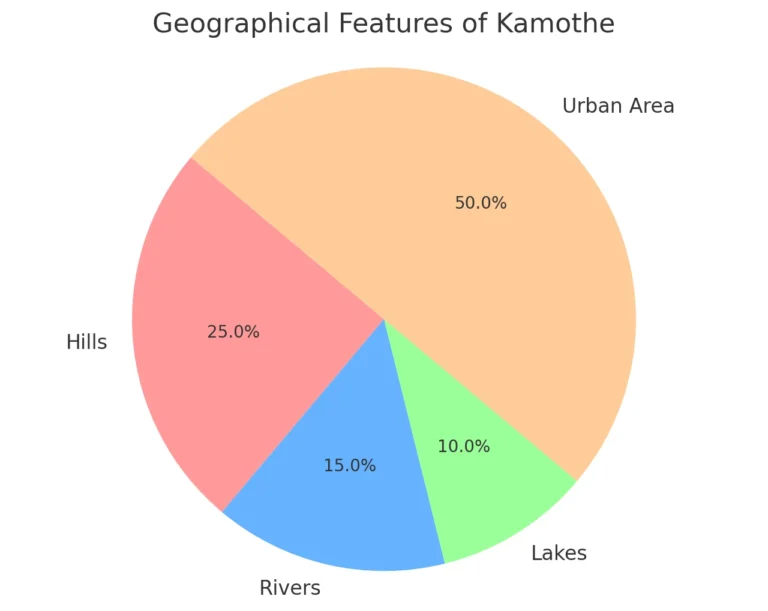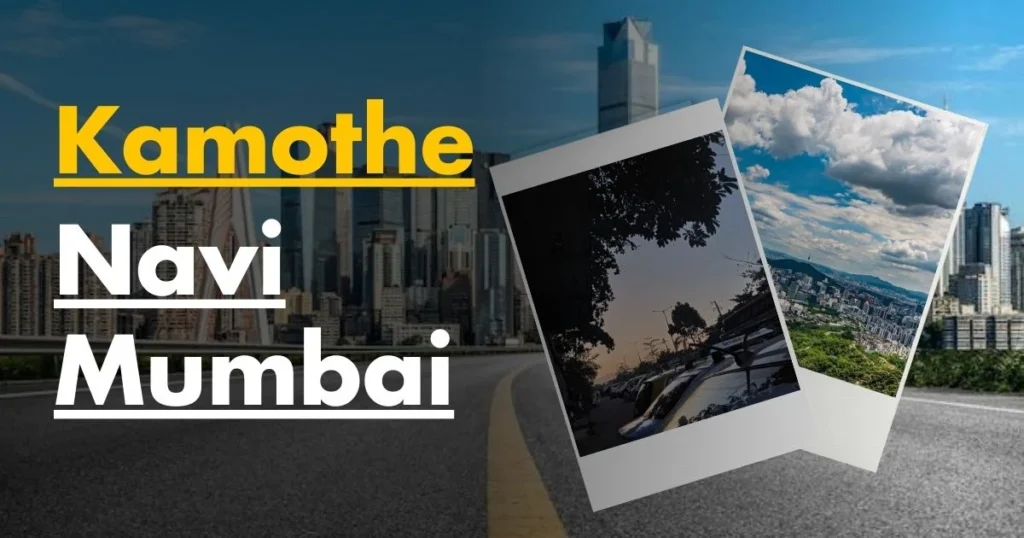Kamothe Navi Mumbai, a well-planned area by CIDCO, It is conveniently located near the Sion-Panvel Highway and Mumbai-Pune Expressway, ensuring great connectivity. The area is growing due to affordable housing, local businesses, and its closeness to industrial hubs Its proximity to the proposed Navi Mumbai International Airport and upcoming metro network adds to its economic value. With good infrastructure, schools, hospitals, and commercial spaces, Kamothe Navi Mumbai has become a popular residential and business hub, playing a key role in Navi Mumbai’s development.
History
A journey from a quaint village of 200 families to a bustling urban center, Kamothe Navi Mumbai’s transformation is a testament to Navi Mumbai’s rapid growth. While pre-independence, its population barely touched 900, today, CIDCO’s masterplan has woven a tapestry of 38 sectors, breathing new life into this once-sleepy hamlet.
Kamothe, located in the Raigad district of Maharashtra, is a relatively new planned node developed by CIDCO (City and Industrial Development Corporation) in the 1990s. However, before its urbanization, the region had a rural and agricultural history tied to traditional Maharashtrian village life. Here’s an overview of what the area might have been like 100 years ago
British History
During British rule, the area now known as Kamothe Navi Mumbai was part of the Bombay Presidency, a significant administrative region under the British Empire. While Kamothe itself was a rural and agrarian village with little direct mention in British records, its history is intertwined with the broader developments in the region. Here’s an overview of Kamothe Navi Mumbai’s context during the British period:
Agriculture: Kamothe Navi Mumbai and surrounding areas were predominantly agricultural, with rice, millets, and pulses being the main crops. Farmers followed traditional methods of farming and relied heavily on seasonal rains.
Taxation: The British imposed high land taxes under the Ryotwari system, which often burdened the local farming communities.
Salt Production: Salt production along the coast near Navi Mumbai was an important activity during British rule. The Salt Acts, which taxed and monopolized salt, may have indirectly affected Kamothe Navi Mumbai’s residents, especially during movements like the Salt Satyagraha (1930).
Railways: The British introduced railways in the region, but the Panvel area (closer to Kamothe Navi Mumbai) saw greater connectivity as it was a key transit point. Kamothe Navi Mumbai itself remained isolated, connected only by basic pathways and local waterways.
Trade: The British focus on Bombay (Mumbai) as a trade hub indirectly influenced the economy of nearby areas like Kamothe, though it remained largely rural.
Geography

Kamothe Navi Mumbai is one of the nodes of Navi Mumbai, located in the Raigad district of Maharashtra. It is a planned township developed by CIDCO (City and Industrial Development Corporation) and is situated in a strategic location within Navi Mumbai.
Location
Coordinates: Kamothe Navi Mumbai is situated approximately at 19.0148° N latitude and 73.0956° E longitude.
Boundaries:
North: It is bordered by Kharghar and Taloja.
East: The Panvel region lies to its east.
South: It is close to Kalamboli, an industrial and residential area.
West: Kamothe is near the Sion-Panvel Highway, providing easy connectivity to Mumbai.
Topography
Plains and Hills: The region consists of flat plains interspersed with low hills, remnants of the Western Ghats.
Elevation: Kamothe Navi Mumbai is at an elevation of about 11 meters (36 feet) above sea level.
Rocky Terrain: The area has rocky outcrops and hard laterite soil, typical of the Konkan region.
Water Bodies
Panvel Creek: Located to the east, this creek is part of the larger Thane Creek system, influencing Kamothe Navi Mumbai’s ecosystem.
Ponds and Lakes: The node has a few artificial and natural water bodies used for local irrigation and domestic purposes.
Wetlands: The area historically had mangroves and wetlands, but many have been affected by urbanization.
Soil and Vegetation
Kamothe soil is mainly lateritic and alluvial, ideal for rice cultivation, though much has been altered by construction. Before urbanization, the area had abundant mangroves, shrubs, and grasses typical of coastal ecosystems. Urbanization has reduced natural vegetation, replacing it with landscaped green spaces.
Special features
Kamothe Navi Mumbai features 48 well-defined sectors, promoting a spacious and organized environment. The area boasts excellent infrastructure and has experienced rapid population growth in recent years.
Demographic
The population of Kamothe Mansarovar / Khandeshwar in 2021 was 250,000. Kamothe Navi Mumbai is a developing locality in Navi Mumbai, Maharashtra. Kamothe Navi Mumbai, is a rapidly developing suburb with a diverse population, modern infrastructure, affordable housing, and growing connectivity.
Climate

Kamothe Navi Mumbai, has a tropical monsoon climate. Summers (March-June) are hot and humid, with temperatures of 30°C-40°C and occasional pre-monsoon showers. Monsoons (June-September) bring heavy rainfall (2,000-2,500 mm) and cooler temperatures (25°C-32°C) but may cause waterlogging. Winters (October-February) are pleasant, with temperatures of 15°C-28°C, low humidity, and dry weather, ideal for outdoor activities. Humidity persists year-round due to its coastal location, with winters being the most comfortable.
Education Institution
Kamothe hosts educational institutions like MNR School, K.P. C English High School, MGM Medical College, and multiple preschools.
Schools and College
Schools
1.MNR School – A well-known school providing quality education from the primary to secondary level.
2. Loknete Ramsheth Thakur Public School-LRTPS strives for excellence, nurturing students to excel academically and in various activities, develop strong intellect, and become responsible citizens.
3. Maji Amdar Dattusheth Patil Vidyalay–
Maji Amdar Dattusheth Patil Vidyalay is a school located in Kamothe Navi Mumbai. It is known for providing quality education and serving the local community.
College

1. MGM College of Engineering and Technology – Offers various undergraduate and postgraduate courses in engineering and technology.
2. Sushma Patil Vidyalaya and Junior College – Sushma Patil Vidyalaya and Junior College in Kamothe offers education from primary to junior college, with courses in science, arts, and commerce.
3. DSP College – DSP College in Kamothe Navi Mumbai, offers undergraduate and postgraduate courses in arts, commerce, and science, with a focus on academic excellence and student development.
Economy
Kamothe economy thrives on real estate, retail, and small businesses, benefiting from its strategic location in Navi Mumbai. Residential developments dominate, while growing commercial spaces support local jobs. Retail stores and service businesses cater to daily needs, and proximity to industrial hubs like Taloja and IT parks boosts economic activity. Improved infrastructure and connectivity to Mumbai and Pune further enhance investment opportunities, driving Kamothe’s economic growth.
Landmark
1. Kamothe Market Area
Kamothe itself boasts a bustling local market area where residents can shop for fresh produce, groceries, clothing, and daily essentials. The market reflects the vibrant community life in the area.
2. Proximity to Major Highways
Kamothe’s location near the Sion-Panvel Highway and Mumbai-Pune Expressway is a landmark in itself, providing excellent connectivity to Mumbai, Pune, and other parts of Navi Mumbai.
3.Shiv Mandir (Temple)
This temple is a spiritual and cultural center in Kamothe, attracting devotees and visitors seeking peace and blessings. It is known for its serene ambiance.
4.Kamothe Police Station
Located centrally, the Kamothe Police Station ensures safety and security for residents. Its presence enhances the area’s law and order situation.
5.MGM Hospital and Medical College
A significant healthcare and educational institution in the region, MGM Hospital provides high-quality medical services, while its medical college attracts students from across India.
Transport
Road Connectivity
Kamothe enjoys excellent road connectivity due to its location near the Mumbai-Pune Expressway and the Sion-Panvel Highway. These roads make it a crucial transit point for travelers heading to Mumbai, Pune, or other parts of Maharashtra.
Mumbai-Pune Expressway: Kamothe is directly accessible from this major highway, ensuring a smooth drive for long-distance travelers.
Sion-Panvel Highway: This arterial road connects Kamothe to key parts of Mumbai, such as Chembur, Sion, and Dadar.
Local roads within Kamothe are well-maintained, connecting the various sectors of this node and ensuring a hassle-free commute within the locality.
Public Transport
Kamothe offers a variety of public transport options for daily commuters:
Buses: Navi Mumbai Municipal Transport (NMMT) and Brihanmumbai Electric Supply and Transport (BEST) buses serve Kamothe, connecting it to Mumbai, Panvel, Kharghar, Vashi, and other nearby areas. Buses are a cost-effective mode of transportation for residents.
Auto-Rickshaws: Autos are the most common mode of local transport in Kamothe, offering quick and convenient travel for short distances.
Taxis: App-based taxi services like Ola and Uber are widely available, providing a comfortable and hassle-free option for commuting.
Railway Connectivity
Kamothe is located close to key railway stations that form part of the Mumbai Suburban Railway network, making it highly accessible to commuters:
Mansarovar Railway Station: The nearest station for Kamothe residents, part of the Harbour Line, connects Kamothe to Mumbai, Thane, and Navi Mumbai.
Panvel Junction: Just a few kilometers away, Panvel is a major hub in the Central Railway network, offering connections to Pune, Karjat, and other destinations. It also serves as a starting point for several long-distance trains.
Trains on the Harbour Line and Trans-Harbour Line ensure Kamothe residents can easily travel to major commercial hubs like Vashi, CST (Chhatrapati Shivaji Maharaj Terminus), and Thane.
Upcoming Infrastructure Projects
Kamothe transport infrastructure is set for major upgrades with key projects underway. The Navi Mumbai Metro Phase 1 will improve connectivity between Belapur, Kharghar, and Taloja. The Mumbai Trans Harbour Link will connect Navi Mumbai to South Mumbai, reducing travel time. The upcoming Navi Mumbai International Airport near Panvel will boost economic and real estate growth in Kamothe.
Private Vehicles
Owning a private vehicle is common in Kamothe due to its well-developed road network. The locality has ample parking facilities, and the wide roads ensure minimal traffic congestion compared to other parts of Mumbai
Intercity Travel
For intercity travel, Kamothe residents benefit from nearby facilities:
Panvel Bus Depot: Provides buses to Pune, Kolhapur, Nagpur, and other parts of Maharashtra.
Long-Distance Trains: Panvel Junction offers long-distance train services to Goa, Karnataka, and South India.
Future Prospects
The ongoing and planned infrastructure projects promise to transform Kamothe into a well-connected and accessible locality. Enhanced metro and airport connectivity will further solidify its position as a sought-after residential hub.
In summary, Kamothe’s transport system is a mix of well-established road and rail networks, complemented by the promise of future developments. Its proximity to major highways and the upcoming international airport ensures that residents and businesses in Kamothe will continue to enjoy excellent connectivity.
Areas of Kamothe
1. Residential Sectors (1-22)
Kamothe is broadly divided into 22 sectors, each offering a mix of residential, commercial, and recreational spaces.
Key Features:
Sector 1 to 9 (East Kamothe):
Predominantly residential with affordable housing options.
Proximity to Khandeshwar railway station.
Green spaces and parks, suitable for families.
Educational institutions and healthcare facilities nearby.
Sector 10 to 16 (Central Kamothe):
A mix of mid-range and premium apartments.
Closer to major markets, retail outlets, and restaurants.
Good road connectivity to Mumbai-Pune Expressway.
CIDCO’s well-maintained infrastructure, including wide roads and drainage systems.
Sector 17 to 22 (West Kamothe):
Recently developed sectors with modern residential complexes.
Proximity to the proposed Navi Mumbai International Airport.
Quiet and less congested compared to the central sectors.
Upcoming commercial hubs and IT spaces.
2. Key Landmarks and Facilities
Khandeshwar Railway Station:
Located centrally, connecting Kamothe to major parts of Navi Mumbai and Mumbai.
Serves as a lifeline for daily commuters.
Parks and Recreation:
CIDCO Garden in various sectors, ideal for jogging and leisure.
Proximity to Panvel Creek offers scenic spots for relaxation.
Healthcare Facilities:
Hospitals like MGM Hospital and Matoshree Multispecialty Hospital provide quality medical care.
Conclusion
Kamothe, with its strategic location, modern infrastructure, and growing economy, offers a balanced lifestyle for residents. Its educational institutions, healthcare facilities, and connectivity make it an attractive destination for homebuyers, businesses, and investors, ensuring continuous development and prosperity.
FAQ's
Frequently Asked Questions
1. Where is Kamothe located in Navi Mumbai?
Kamothe is a node in Navi Mumbai, situated along the Sion-Panvel Highway and near the Mumbai-Pune Expressway. It is part of the Raigad district and is managed by CIDCO.
2. How is the real estate market in Kamothe?
Kamothe is a rapidly developing residential area with affordable housing options. It attracts middle-class families and working professionals due to:
Affordable property prices compared to Mumbai.
Modern infrastructure and amenities.
3. How is the water supply and electricity in Kamothe?
Kamothe has a reliable water supply managed by CIDCO and power supply through MSEDCL. However, some areas might face water shortages during peak summer.

